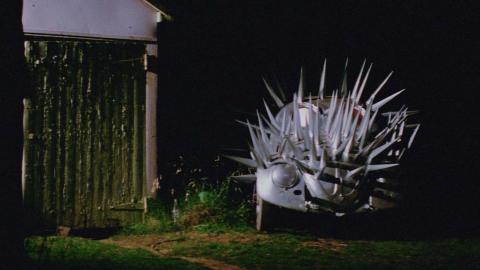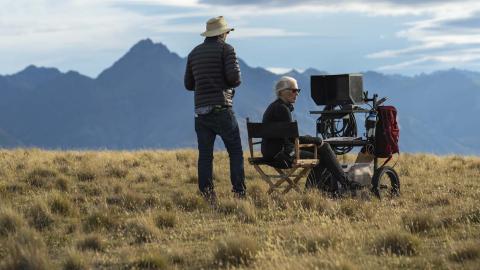

Ôshima Nagisa

‘I have no way to make films except by examining the Japanese and endeavouring to discover who they are.’
Ōshima Nagisa
The January 2013 death of Japanese filmmaker Ōshima Nagisa (born 1932) was not unexpected. Having suffered a series of massive strokes in the late 1990s, he had long ago largely abandoned filmmaking, beyond a few personal documentaries, one feature, and habitual Japanese TV talk show appearances – he was a regular on Iron Chief. Yet coming so soon after the death of that other iconoclast of 1960s erotic-political cinema, Wakamatsu Koji – and followed just a few weeks later by the loss of Donald Richie, the critic who had done most to open western eyes to the greatness of the Japanese cinema tradition – it seems that a great era of Japanese cinema has passed into history.
Ōshima was the internationally best known of a generation of filmmakers that scorched their way across postwar Japanese cinema from the late 1950s until the ‘80s. ‘Outlaw masters’ like Wakamatsu, Suzuki Seijun, Shinoda Masahiro, Imamura Shōhei and Adachi Masao all began within the strict, hierarchical Japanese system of studios like Shochiku and Nikkatsu in the 1950s and early ‘60s. All then fought, lost and then rebelled against the system in the 1960s and ’70s making fast and wild films (often released and sometimes funded through the Art Theatre Guild distribution collective) that were anti-establishment, narratively unpredictable and predictably radical.
Was Ōshima the greatest filmmaker of these peers? That’s still a subject for further inquiry by Japanese and western critics. He was certainly the best known internationally – and within Japan maybe the most politically and culturally visible; he acted somewhat as Pier Paolo Pasolini did in Italian cinema and culture. He was a fashionable director who also had many parallel cultural lives, especially as a radical cultural theorist and as a provocateur, gadfly and combative public intellectual.
Ōshima’s career trajectory can be seen as following the tumultuous modernisation of Japan in the second half of the 20th century, especially through its most acute phase in the 1960s and ‘70s – and maybe also its post-1990s stagnation. He was one of the trio of apprentice directors suddenly promoted in 1960 by major Japanese studio Shochiku, when it felt it needed new blood (and new French-style ‘new wave’ films) to respond to Japan’s then much talked about and newly affluent ‘Sun Tribe’ youth market.
Prior to that (and perhaps a factor Shochiku had in mind) he’d been a notorious student political activist at Kyoto University in the mid-1950s. Unsurprisingly, political allegory is implicit in the doomed teen romances of first films like A Town of Love and Hope (1959), The Cruel Story of Youth and The Sun’s Burial (both 1960s). However, each was cool, reasonably generic and made some money. Then Ōshima really took the studio at its word with his next feature, Night and Fog in Japan (1960). An experimental (it has just 25 shots), brooding, Brechtian talk-drama on the crisis in Japanese radical politics, there have been few so willfully non-mainstream ‘studio’ films like it anywhere, before or since (Dennis Hopper’s equally doomed The Last Movie, perhaps?).
Night and Fog in Japan was quickly suppressed by Shochiku and Ōshima was sacked. Yet he went on to flourish (often with mainstream studio funding). Films like Sing a Song of Sex, Three Resurrected Drunkards (both 1967), and Japanese Summer… (1968) were made in a mood to shock and in a mode of political and sexual sensationalism that came at just the right time. Formal provocation was sometimes clearer than content in these early- to mid-career films and Ōshima suddenly became Japan’s internationally emblematic chic art cinema radical (much as at the time Antonioni was for Italy, Godard for France, or Fassbinder for Germany). Yet in at least Violence at High Noon (1966), Death by Hanging (1968) and especially in Boy (1969) and The Ceremony (1970), there was a profound development on the genre allegories of Ōshima’s first films at Shochiku.
As far back as in Cruel Story of Youth he’d had an interest in going to the newspaper headlines for inspiration. Now lurid, true-life crimes, scandals and cause célèbres became the weapons with which to fire his social critique. Each film seemed to realise the filmmaking he’d argued for as far back as a 1958 essay: one that uses ‘… critical spirit and powers of expression in a persistent struggle … against the pre-modern elements of Japanese society’. Nearly all took the sensational outbursts of Japanese society and culture – episodes of violence, crime, of taboo sexuality and of xenophobia – and turned them into scandalous allegories. They were not really about the sensational behaviour which initially drew audiences in. They showed how transgression and disgust exposed what was for Ōshima the true, unreformed and deeply reactionary nature of Japanese power and social authority.
In the Realm of the Senses (1976) became the most notorious of these. Ōshima’s films always worked the fine line between exploitation and critique, between gratuity and necessity. That line is most tested, but also most skillfully negotiated, in a graphically erotic, but also acutely politically attenuated version of the (for Japanese cinema) oft re-told Abe Sada murder case of 1936. It signalled Ōshima’s intention to publically divorce himself from the Japanese industry and become a ‘world filmmaker’ – not just because In the Realm of the Senses was made with funding from, and post-produced in France, but because its sex scenes were not even acceptable in Japan’s notorious, soft porn ‘pink movie’ industry. Japan was not the only nation where the film was banned; only edited versions were seen in Australia until 2000.
Yet in cutting his ties with the Japanese industry, Ōshima was to suffer the fate of so many art cinema globetrotters. His subsequent international films are often important, but are sometimes also tarnished by a perpetually stateless feel in their realisation. Empire of Passion (1978) feels like a cash-in on In the Realm of the Senses. Merry Christmas, Mr Lawrence (1983) is his best-known film, audaciously cast and is the ‘queer’ war movie the director needed to make, but the match of themes and acting styles is only occasional smooth. Max Mon Amour (1986) is a real oddity, but Ōshima seems like a Luis Buñuel stand-in. Only the greatly underrated Gohatto (1999) seems to fully gel – his final film, only Japanese studio feature after 1978 and only work in the classic Japanese jidaigeki (period samurai) genre.
Another – sadly unrealised – project of this period, Hollywood Zen, seemed to be a metaphor for Ōshima’s latter decades. A biopic of the Hollywood silent-era star Sessue Hayakawa, it would have been an account of another Japanese international cinema superstar with a troubled, rootless and under-utilised late career.
Yet prior to 1976, Ōshima was as compulsively prolific as many Japanese filmmakers can be, often making one to two films per year and jumping causally back and forth into TV and documentaries. This Arc Cinema program is just a selection of the key films, in large part suggesting that it’s time to review the real achievements of his international hits of the 1960s, ‘70s and ‘80s. In small part the program also acknowledges a surprisingly large collection of the director’s films held in the NFSA collection, and the passion for Ōshima’s work of a number of Australian cinephiles and distributors who helped to build this local resource over many years.
The National Film and Sound Archive of Australia acknowledges Australia’s Aboriginal and Torres Strait Islander peoples as the Traditional Custodians of the land on which we work and live and gives respect to their Elders both past and present.


